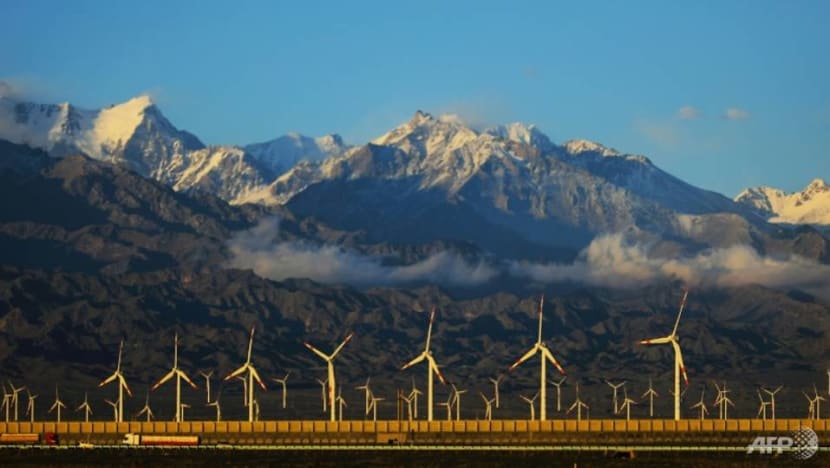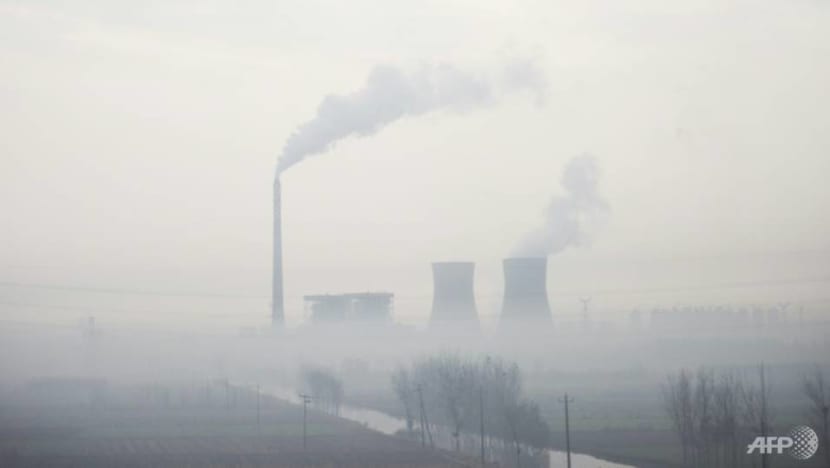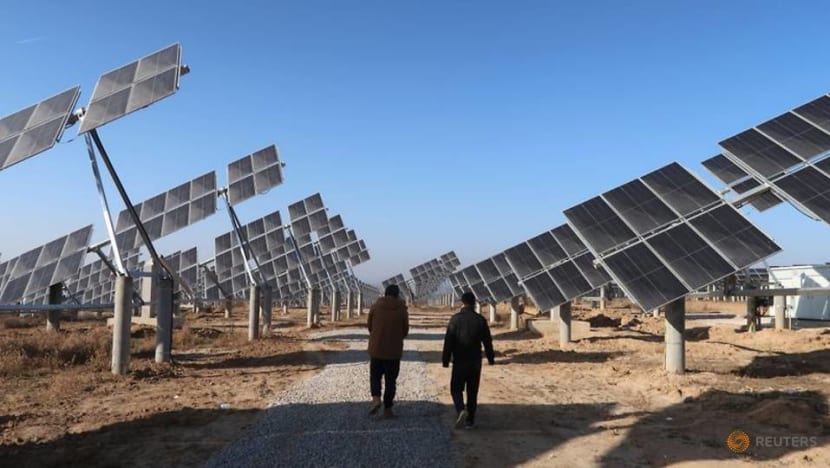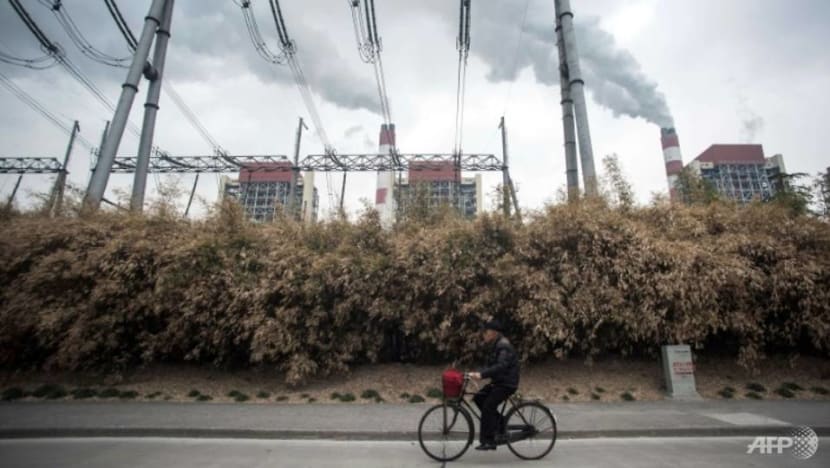commentary Commentary
Commentary: Why China believes it’s go big on carbon emission cuts or go home
China aims to achieve carbon neutrality by 2060. The challenges ahead are daunting and the socioeconomic costs high, but meeting these targets could significantly reduce global warming says EAI’s Chen Gang.

Wind turbines are seen in 2018 in the Dabancheng district in Urumqi in China's northwestern Xinjiang region. AFP/STR
SINGAPORE: When President Xi Jinping announced China’s goal of achieving carbon neutrality by 2060 last September, local officials responded by cracking down on carbon-intensive industries.
Tangshan city in Hebei province, China’s steelmaking hub, ordered factories to cut production by 30 to 50 per cent by the end of 2021, triggering thousands of lay-offs.
Tangshan’s cutback is part of China’s plan to slash 550 million tonnes in steelmaking capacity from last year’s production of 1.1 billion tonnes.
As the world’s largest producer of crude steel, China’s capacity cut will push up global steel prices, increasing inflation risks for the domestic and global economy amid the pandemic.
At the Leaders Summit on Climate last April, major carbon emitters such as China and the US have pledged to reach net zero emissions by mid-century, in line with the Paris Agreement.
READ: Commentary: Cooperation between US, China at global climate summit could yield significant benefits
READ: Commentary: To everyone’s relief, US is back in the driver’s seat on climate change
The tough action in Tangshan could herald what is to follow. Since much of climate change is caused by industrial activities that require burning fossil fuels such as coal, oil and natural gas, most mitigation actions must include cutting back on fossil fuels.
They are more polluting, but still cheaper and more stable compared to renewable sources like solar and wind.
China, the world’s largest carbon emission country that accounts for about 28 per cent of the world’s total, had been in defence mode since the Copenhagen Climate Summit in 2009 when it came under international scrutiny for its fast-growing greenhouse gas emissions.

Fearing that exorbitant mitigation cost might slow down the economy and lead to unemployment, China had long shied from direct emission reduction obligations until recently, when President Xi announced the 2060 target to the United Nations.
International attention aside, the driver of China’s push to reduce carbon emissions has been growing domestic recognition that dirty industries must be curbed to minimise pollution in cities, and so the country has embarked on a sustainability drive.
In spite of that, the challenges ahead are daunting, and the socioeconomic costs will be very high, especially in the short term.
COAL, THE STICKING POINT
The sticking point for China is coal. The country’s massive energy demand exacerbates the problem. As the world’s largest energy consumer, China accounts for about 24 per cent of global energy consumption, demanding the energetic equivalent of almost 3.3 billion tonnes of oil in 2019.
Since 2011, it has burnt more coal than all other countries combined. China still sources 58 per cent of its total energy consumption from coal burning in 2020.
A pathway to net zero by 2060 will require a radical shift away from a coal-dominant energy mix, with renewables making up the bulk instead.
Yet in reality, China still put 38.4 gigawatts of new coal-fired power capacity into operation in 2020 to power its pandemic-hit economy, which was more than three times the amount built elsewhere around the world.
READ: China doubles down on coal plants abroad despite carbon pledge at home
READ: Commentary: Oil and gas is not the sunset industry you think it is
China also remains the world's top crude oil importer, surpassing the United States in 2017, and largest natural gas importer, overtaking Japan in 2018.
It’s true that alongside China’s insatiable appetite for conventional fossil fuels, the country has been quickly building up capacities of non- fossil fuels including wind, solar, hydro and nuclear power.
Yet variables such as geographic and meteorological conditions, domestic supporting industries, and technological barriers related to power storage and transmission have constrained the country’s renewable energy development.
China today is facing the world’s highest rejection rates for its existing wind and solar power capacity. Wind and solar only generate electricity when the wind is blowing or the sun is shining. Such intermittency makes it challenging for conventional grids, which have little storage capacity, to incorporate renewable energy.

Thus, a substantial part of the potential energy generated by wind turbines and solar panels in the western areas cannot transmit to the power grids connecting the economically vibrant coastal areas.
TRADEOFFS WITH GROWTH AND COMPETITIVENESS
In the past few years, Beijing has closed numerous polluting factories in thermal power generation, steelmaking and cement production in the name of “supply-side” reform.
But such a top-down approach has limited impact on local capacity expansion, since mercantile policy priorities defined by central-local relationships and interest groups remain intact.
On some occasions, the administrative edicts of reducing local industrial capacity met strong resistance. Not only was the local economy hit, but the closure of factories also led to unemployment and social instability, like in the case of Tangshan.
READ: Commentary: Is China’s ambitious carbon pledge just lip service?
China still wants to achieve a 6 per cent economic growth for 2021, trying to consolidate its status as a global economic powerhouse. The blitz on those heavy industries, however, may bring headwinds to its fledging economic recovery.
A pathway to net-zero by 2060 requires China to reduce emissions to 6,247 million tonnes from the baseline 10,039 million tonnes by 2025, or the end of China’s 14th Five-Year Plan.
Under existing policies and technology trends, such aggressive mitigation efforts may come at the cost of slower economic growth, declining competitiveness for Chinese products and loss of job opportunities in this period.
Higher-quality South Korean and Japanese producers will have an edge over Chinese steelmakers if China further raises environmental standards to cut emissions.
READ: Commentary: The troubling truth behind China’s carbon neutrality pledge
China’s great leap forward in promoting non-fossil fuels will also depend on whether the government’s robust subsidies for the emerging low-carbon electricity industry are enough to move the financial needle.
Both hydro and nuclear power projects are environmentally risky and need considerable front-loaded investment. Wind and solar power projects are capital-intensive as well, despite negligible fuel costs.
In addition, wind and solar power generation can be highly variable at different timescales, and therefore pose substantial challenges in incorporating the generated electricity into grid systems, which ultimately increases costs for producers and consumers.

To solve the problem for the long term, China has to transform its mitigation efforts from a top-down and state-driven model into a market-based one, and with fewer policy interventions from the government.
For years, China has been facing huge wastages associated with overinvestment and overcapacity in renewable energy development. The new carbon neutrality pledge could result in more rush-to-build actions in wind and solar power generation. A surge in installed capacity will lead to more inefficiencies and curtailment.
READ: Commentary: The changing geopolitics of clean energy will impact Singapore’s Green Plan
BUDDING SHOOTS FOR A GREENER ECONOMY
There are budding shoots from this overall drive towards market solutions for a greener economy as incentives align to shape corporate behaviour.
China’s establishment of a nationwide carbon trading market, in which thermal power plants and other polluting companies have to buy carbon credits if their emissions exceed the quotas assigned to them.
This will help the country to gradually form carbon prices based on supply and demand on the market, relying less upon administrative edicts of shutting down industrial facilities.
In the long run, if China can change its baseline carbon emission trajectory through technological innovation, market-based mechanisms and improving people’s climate consciousness, the benefits will greatly outweigh the cost.
READ: Commentary: China’s move on climate action signals arrival as a ‘hybrid superpower’
If China succeeds, its ambitions would effectively shave 0.2 to 0.3 degrees Celsius from global heating forecasts for 2100, down to around 2.4 to 2.5 degrees Celsius above pre-industrialised levels.
This is still well above the 2 degrees Celsius limit set by the Paris Agreement, but it will be a significant improvement from the business-as-usual scenario.
Carbon neutrality will also help China achieve energy self-reliance, as domestic renewable projects will have to make up the majority of energy infrastructure by 2060.
This complements President Xi’s “dual circulation” strategy, which focuses on domestic supply and demand, rather than reliance upon foreign economies.
(Can China make good on its climate targets? Chen Gang gives his take on CNA's The Climate Conversations:)
Chen Gang is Assistant Director and Senior Research Fellow of the East Asian Institute, National University of Singapore.












